The ASRock Rack EPYCD8-2T Motherboard Review: From Naples to Rome
by Gavin Bonshor on April 20, 2020 9:00 AM EST- Posted in
- Motherboards
- AMD
- Workstation
- server
- ASRock Rack
- Naples
- Rome
- EPYC 7351P
- EPYCD8-2T
Visual Inspection
The ASRock Rack EPYCD8-2T is an ATX motherboard which features support for both AMD EPYC 7001 (Naples) and EPYC 7002 (Rome) single-socket processors. The EPYCD8-2T has a single transposed socket to allow for optimal airflow when used within a 1U chassis, but this model is also compatible for use in regular chassis that support ATX motherboards. ASRock Rack is using a green PCB with blue memory and blue PCIe 3.0 slots, with silver aluminium heatsinks for the power delivery and controller set.
Even though the EPYCD8-2T is using an ATX sized PCB, ASRock Rack has managed to fit a total of seven PCIe 3.0 slots, with four full-length PCIe 3.0 x16 slots, and three open ended half-length PCIe 3.0 x8 slots. These slots from top to bottom operate at x16/x8/x16/x8/x16/x8/x16.
For this model to support EPYC 7002 processors, users who end up with one of the earlier runs will need to perform a BIOS update. (Our board was so fresh, it only came with a 16 MB chip, whereas a 32 MB BIOS chip is needed - ASRock informs us all retail units have the 32 MB chip).
For storage, the ASRock Rack EPYCD8-2T has the capability to support up to nine SATA devices. This is possible with two miniSAS HD slots with each slot supporting up to four SATA devices, with a SATA DOM also present on the board. In addition to the SATA are two PCIe 3.0 x4 M.2 slots, which also support SATA M.2 drives. Although the EPYCD8-2T doesn't include U.2 ports directly, it includes two OcLink ports so U.2 drives can be used.
Touching on cooling support, the EPYCD8-2T has a total of seven 6-pin fan headers with one for a CPU fan, and six for chassis fans. Four of the chassis headers are assigned to front fans, and two for rear fans, which signifies official support for users looking to install this board into a 1U chassis. For power, a 24-pin 12 V ATX is present to provide motherboard power, with an 8-pin and 4-pin for CPU power. ASRock Rack also includes a 6-pin connector to provide additional power to the PCIe 3.0 slots.
Along the bottom of the board is a number of headers including a USB 2.0 header which supports two additional ports, a TR1, TPM, BMC_SMB and IPMB headers. A two-digit LED debugger is also present for troubleshooting potential POSTing failures. A large silver aluminium heatsink is located in the bottom left-hand corner for the board which keeps the board's controller set cool This includes the Aspeed AST2500 BMC and Intel X550 dual 10 G Ethernet controller, as well as the Realtek RTL8211E Gigabit controller designated for the boards IPMI.
The power delivery on the ASRock Rack EPYCD8-2T is using a basic 7-phase configuration for the CPU. The power delivery does include a small heatsink which uses screws to retain pressure. The EPYCD8-2T has support for up to 64-core EPYC 7002 processors and is more than capable to power such a powerful professional-grade processor.
On the rear panel is very little in the way of input and outputs, with just two USB 3.1 G1 Type-A ports present. To enable more, users will need to make use of the single USB 3.1 G1 header which offers two additional ports. A single USB 2.0 header also provides two extra ports bring the boards total of USB support up to six when factoring in the ports on the rear panel. Located above the two USB 3.1 G1 Type-A slots is a Realtek RTL8211E dedicated management Gigabit port, with a further two 10 G Ethernet ports powered by an Intel X550 10 G controller. Also present is a UID button with LED, a D-sub video output powered by the Aspeed AST2500 BMC controller, and a serial port.
What's in the Box
Included in the retail packaging is a small, yet effective accessories bundle is a rear panel I/O shield, a single SATA cable, a mini SAS to four SATA port cable, two M.2 installation screws, and a quick installation guide. ASRock doesn't distinguish between retail packaging and bulk packaging on the official product site.
- SATA cable
- mini SAS to four SATA cable
- 2 x M.2 installation screws
- Quick installation guide
- Rear panel I/O shield


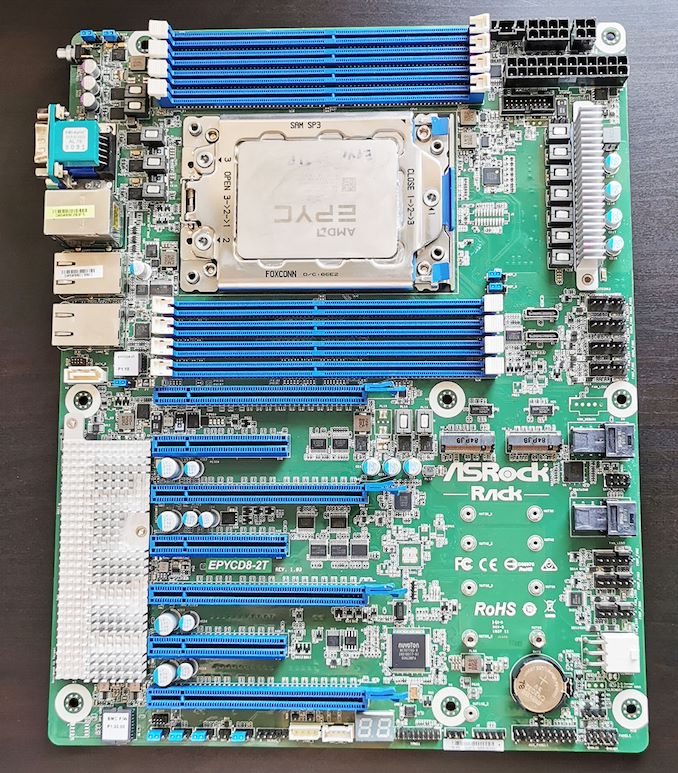
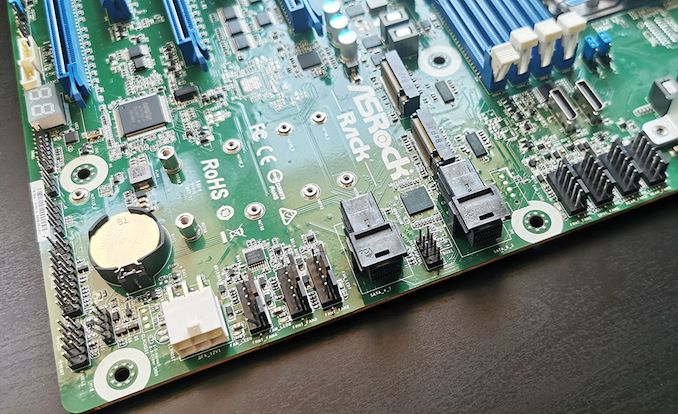
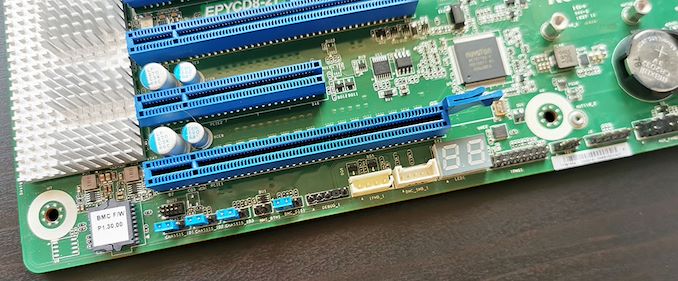
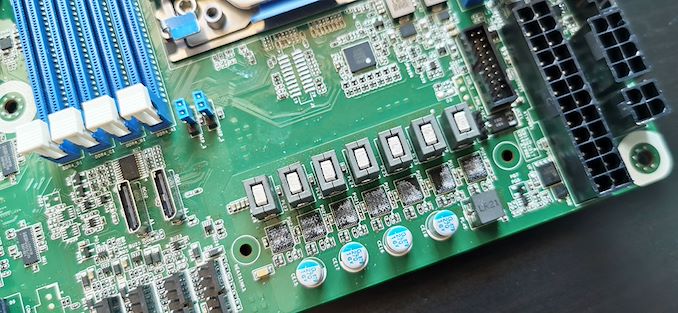

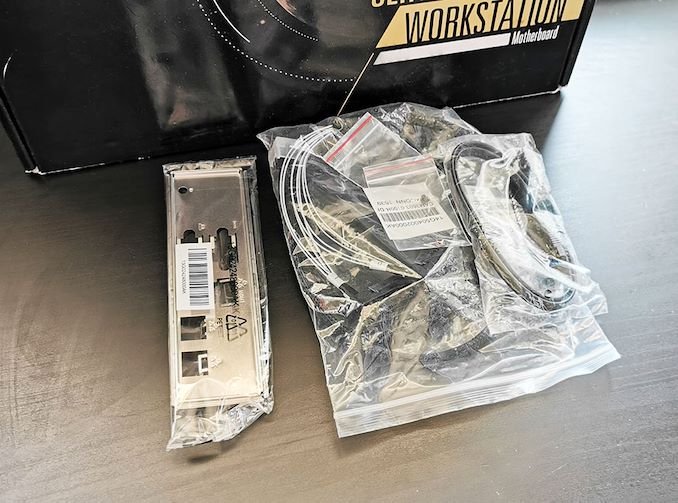








34 Comments
View All Comments
romrunning - Monday, April 20, 2020 - link
Would it be possible to get a review of more recent AMD server boards from ASRockRack, like the ROMED8HM3 (SP3 socket, supports EPYC Rome, has many PCIe 4.0 slots)?Slash3 - Monday, April 20, 2020 - link
The ASRock Rack ROMED8-2T is a similarly near perfect board for the current Epyc CPUs; I'd love to see some reviews once it hits retail channels (within a few weeks, hopefully).https://www.asrockrack.com/general/productdetail.a...
cygnus1 - Monday, April 20, 2020 - link
I plan to build a new home server before the end of the year so I went and checked that one out. I do want it to be AMD, and not really caring if it's Epyc or Ryzen, just need to find a good board with IPMI like these AsrockRack ones. The only problem I see for me with the ROMED8-2T is no x16 slots and the x8 slots are all closed ended for some reason, so you can't even put an x16 card in them.brucethemoose - Monday, April 20, 2020 - link
All 7 slots on the ROMED8-2T are x16.https://www.asrockrack.com/photo/ROMED8-2T-1(M).jp...
Foeketijn - Tuesday, April 21, 2020 - link
Not sure what the requirements are, but I can endorse the Asrockrack X470 boards. Ryzens Zen2 and the x470 make a really efficient powerhouse (just 100 Watts for a 8 core in a noisy but cool 1u server doing stress testing)romrunning - Monday, April 20, 2020 - link
Or the ROMED8-2T or ROMED8QM-2T? Really, I guess any of the newer "ROME" models that ASRockRack has listed. These newer boards would be more relevant than the older EPYCD8-2T, of which the ROMED8-2T seems like it's the direct successor.Mr Perfect - Tuesday, April 21, 2020 - link
Yes, please review Epyc boards with PCIe 4. There are several in this price range that have it, so it's not really beneficial to look at boards of the same cost that have half the IO bandwidth.Tyan's S8030GM4NE-2T has five x16 4.0 slots and the two 10gb Ethernet ports. I'd love to know if that board was any good.
shabby - Monday, April 20, 2020 - link
Only two 10g ports? Come on where are my 100g ports...vladpetric - Monday, April 20, 2020 - link
100g is not something that a CPU-based system can saturate. High end switches, aggregating traffic from multiple end points - sure. Software running on a CPU - no.eastcoast_pete - Monday, April 20, 2020 - link
I don't think that question was asked in earnest. However, if it was, I agree with you.